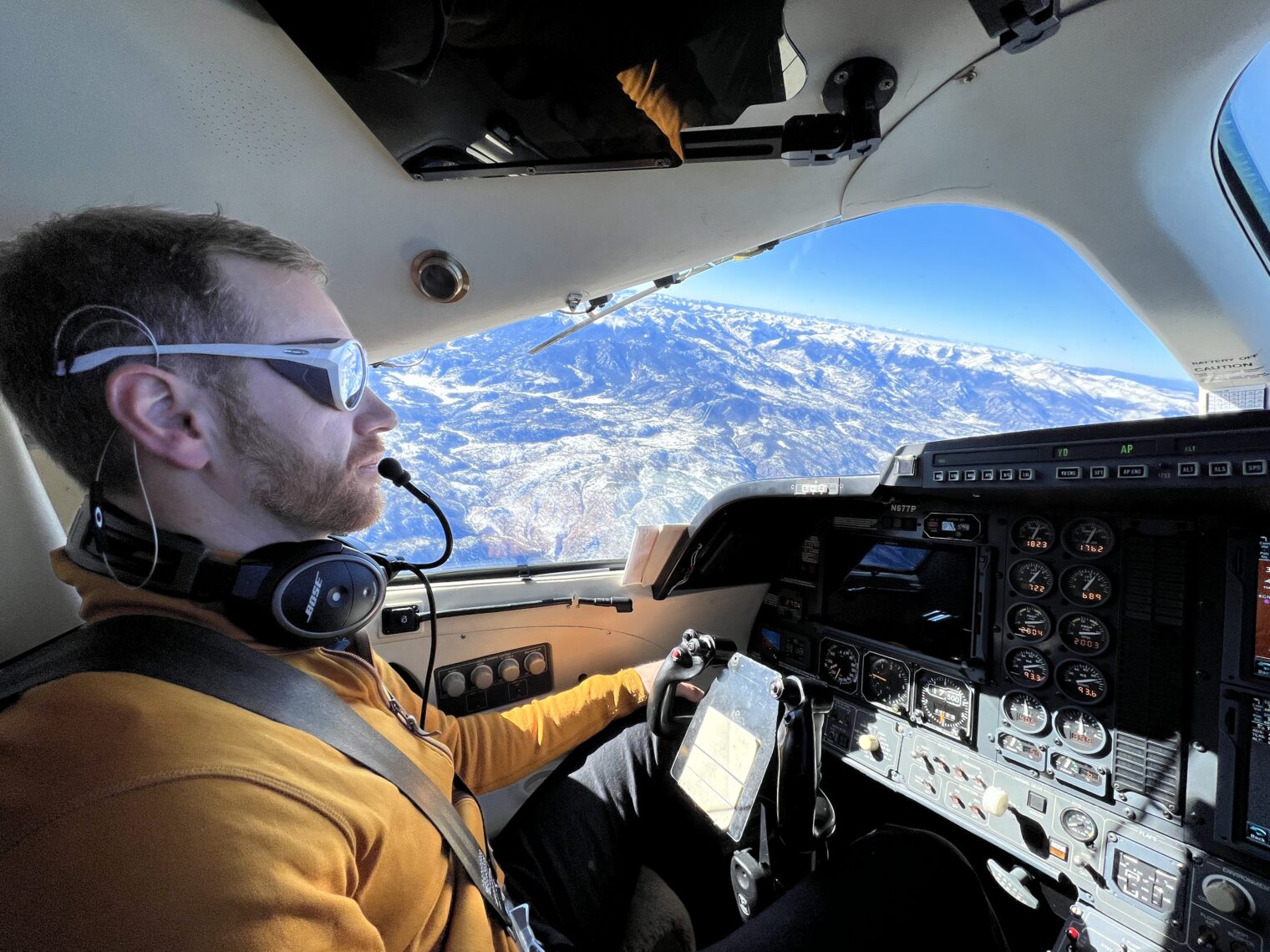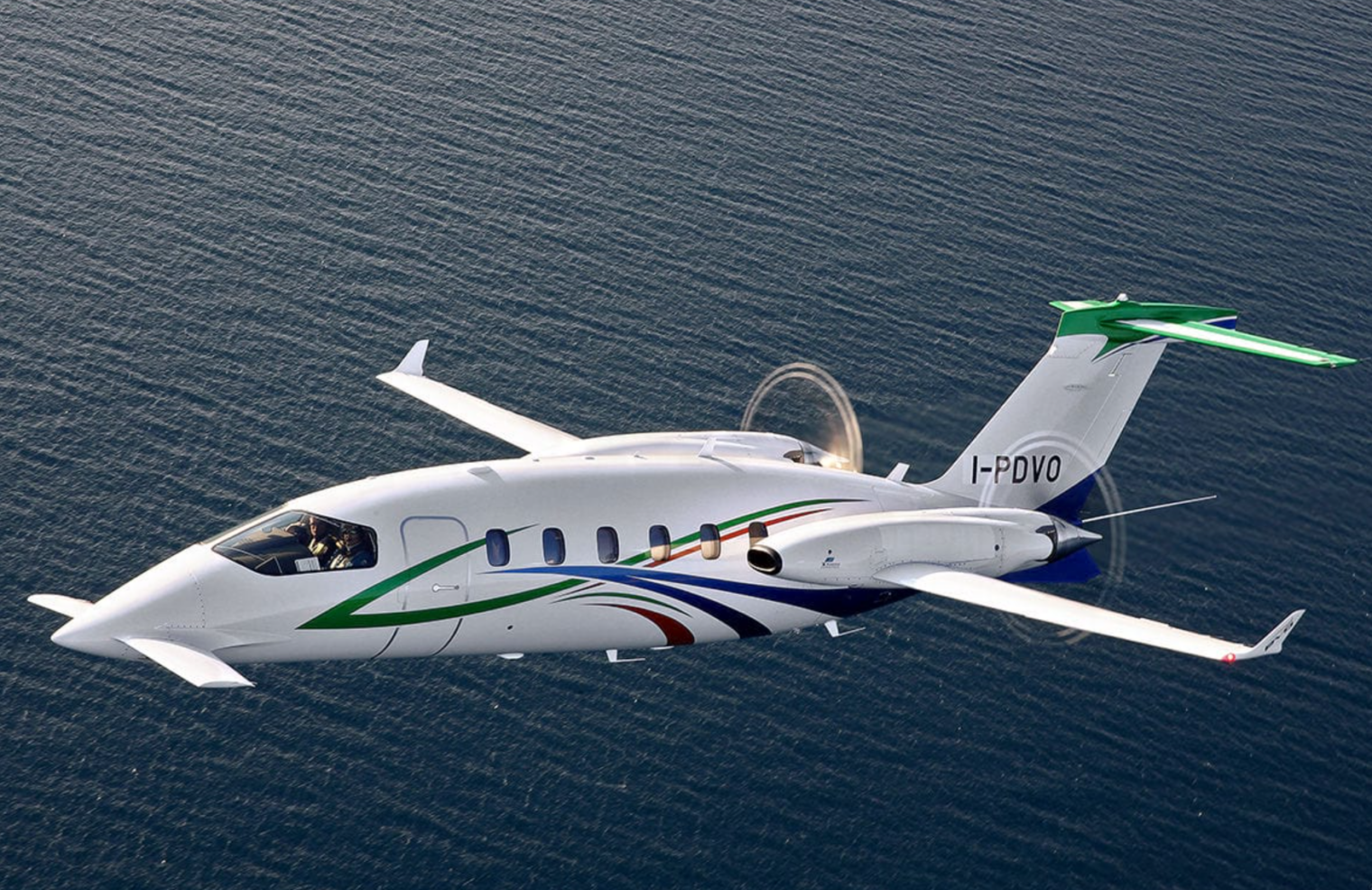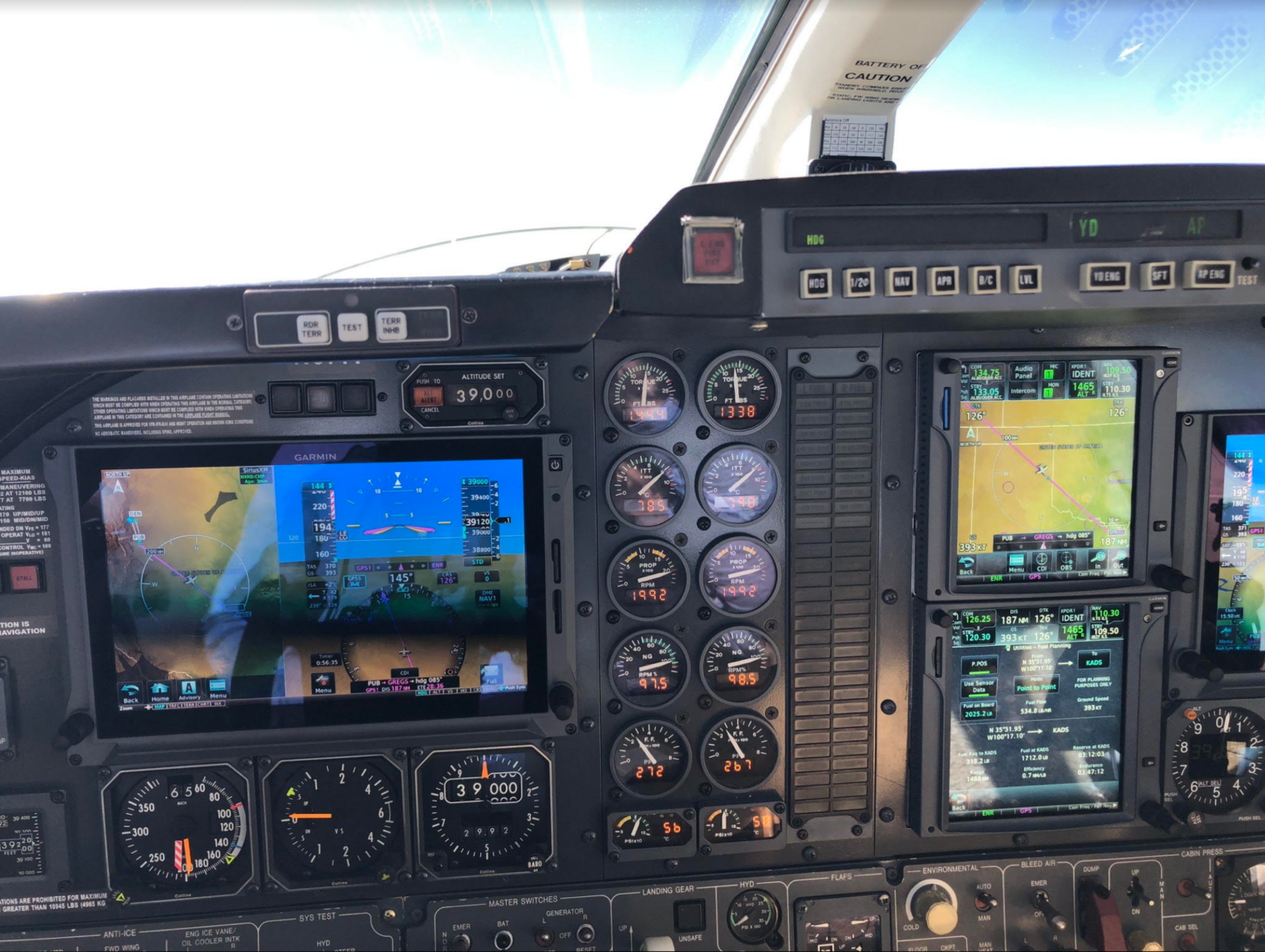For folks who’ve been beguiled by press releases from Otto Aviation, the Piaggio Avanti is a reminder that most of the great ideas in aerodynamics were implemented in the 1980s. The Piaggio designers threw out the rulebook on what an executive turboprop should look like and came up with a three-wing plane that goes 100 knots faster and 10,000′ higher using the same engines as a (two-wing) King Air.
The folks behind Piaggio have long claimed that the Avanti is exceptionally quiet inside, throwing out a 68 dBA number that never seemed credible.
A friend owns a 1992 Piaggio and graciously took me up to 17,500′ to make some measurements. Note that the company claims that the latest Evo model, which has a more advanced Hartzell propeller shape, is actually “20%” quieter. My friend says that a 2008 Piaggio that he flew was noticeably quieter than his 1992 model, so there may actually be three levels of Piaggio Avanti interior noise and the numbers below are the worst that one will ever see.
At Pilatus PC-12 speeds, i.e., 289 knots (222 indicated), sound at the pilots’ ears was about 72 dBA and up to 76 dBA in the passenger cabin (closer to the props spinning on the back of the main wings; closer to the door that whistles a bit (there is a trick to sealing it with a cloth that we didn’t apply for this short flight)).
At 311 knots (240 indicated), cabin noise was 1-2 dBA higher.
The owner says that the plane is noticeably quieter at its normal long-distance cruising altitudes so it is possible that the 68 dBA number is real at FL410! (He’s usually at FL370 and 370 true on 580 lbs/hour; against a headwind (and there is always a headwind because G*d hates pilots!), this is less fuel per mile than a single-engine PC-12.)
Should we all be envious of Piaggio Avanti owners? The plane is more complex to operate than the newest twin-engine turbojets that are certified for single pilots. There are switches to turn on the bleed air, for example, that typically should be thrown just before taking the runway (you’re probably taxiing with a tailwind and the result of leaving the bleeds on is some exhaust smell in the cabin). The steering has two modes, controlled by a switch on the yoke, and one is used for taxi while the other is used once 65 knots is reached on the takeoff roll. There is an autofeather mechanism that will reduce drag from a dead engine and it needs to be verified operational. Speeds are terrifying from a Pilatus PC-12 or even a Cessna Mustang pilot’s perspective. Rotate at 110 knots. Vmc is 100 knots (you can’t fly slower than this with one engine at full power and the other dead with prop feathered), final approach speed is 120-125 knots. The plane slows down very effectively with beta (twisting the prop blades to get some reverse thrust) and therefore a 5,000′ runway is plenty, but it will never compete with a Pilatus or King Air for short field performance. The Piaggio is also the wrong machine for grass, dirt, and loose gravel runways (see Burning Man for turboprop pilots for what a PC-12 can easily do if the Bay Area heroes are ever brave enough to gather again).
My friend says that the cabin is bigger than the PC-12’s (see diagrams below), but it felt smaller to me. Maybe it is the lack of a flat floor. Certainly you’ll never appreciate the genius of the Cirrus Vision Jet designers in making the pilot seats slide back 4′ until you’ve tried to get in and out of a Piaggio front seat. The pedestal extends all the way back to the seatbacks. Unless you’re a 5’2″ tall Italian yoga instructor, I’m not sure how it can be safe to get in and out during flight (without knocking a lever or switch). There is a bathroom all the way in the back, but it is not externally serviced (i.e., the owner-pilot of the $8+ million new Piaggio Avanti Evo will end up carrying a bucket out of the plane…).
The ice protection system is far better than on most newer planes. There is an automatic ice sensor that turns on the boots that protect the engine inlets. The main wing is heated via bleed air. The front wing is electrically heated. The tail is left alone and somehow the plane passed all of the certification tests and also has worked well in the real world (the Italian military operates some with more than 15,000 flights hours). (The HondaJet has a sensor-activated anti-ice system; most airplanes rely on pilots to use their eyes to notice ice building up and then set switches correctly.)
The pressure differential is 9 psi, enabling a sea level cabin up to 24,000′ and 6,600′ cabin altitude at FL410. Compare to 5.75 psi on the PC-12 and a cabin altitude of 10,000′ when the plane is at its service ceiling of FL300.
The older planes can be converted to dual Garmin G600TXi for primary flight display, but, due to the small number of eligible planes out there, there is no likelihood of Garmin certifying its modern engine instruments and GFC 600 autopilot. Below is my friend’s panel. Note the tall stack of warning lights right next to the tall stack of round dials for engine indications and remember that behind each warning light is a system that could suffer an intermittent failure that is challenging to troubleshoot. The old Collins autopilot is in the top center of the panel and the autopilot mode is currently indicated only on the lights above the switches (i.e., not on the PFD).
It would be interesting to see what could be done by upgrading the airplane with the latest GE turboprop (more fuel efficient and FADEC) and a lot more automation, e.g., changing the steering mode automatically, descending automatically in the event of depressurization (the latest planes with Garmin flight decks can do this), land itself if the old/rich guy in front croaks (trophy wife remains in middle seat and has reactivated her Tinder subscription before the flaps and gear are down), etc. If the number of switches and dials could be reduced to what you see in a Cirrus Vision Jet, and the service and support could be more like what the rest of the Jet A-powered world is used to, the Piaggio Avanti would live up to its revolutionary promise.
Some photos from our lunch-time excursion and the POH:




How does the above cabin cross-section compare to the PC-12?
If we assume 2.9′ as the mean radius of the Piaggio, that’s a cross-sectional area of 26.4 square feet. If we multiply the above numbers for the PC-12, we get roughly 24.2 square feet.
The PC-12 does seem to be longer in the back, 16’11” from the front of the passenger door to the rear of the cargo area. On the third hand, the Piaggio has a heated, but not pressurized, 67″-long baggage area behind the cabin.



“The definitive Piaggio P180 Avanti thread”: https://www.beechtalk.com/forums/viewtopic.php?f=49&t=110145
summary: like Italian cars (and women?) its an exotic, temperamental, high-performance beauty that demands attention and money.
1654 posts! That is an epic thread.
Your technical knowledge and skills are impressive. And you fly helicopters, too!
Beautiful plane and technologically impressive esp. for the time. My father saw one up close and toured the interior for about 20 minutes in the early 2000s. He’s not a pilot but he was really taken aback by that plane.
@Philg: Although the lines are beatiful, to my novice eyes the wings look smallish for the size of the aircraft they’re lifting. There must be some flight dynamic compromises as a result of that?
I think I see the biggest compromise here:
>Speeds are terrifying from a Pilatus PC-12 or even a Cessna Mustang pilot’s perspective. Rotate at 110 knots. Vmc is 100 knots (you can’t fly slower than this with one engine at full power and the other dead with prop feathered), final approach speed is 120-125 knots. The plane slows down very effectively with beta (twisting the prop blades to get some reverse thrust) and therefore a 5,000′ runway is plenty, but it will never compete with a Pilatus or King Air for short field performance.
Alex: Yes, as you correctly surmised, the negative of high wing-loading (weight to wing area ratio) is higher minimum speeds for landing and takeoff (and therefore longer runways required). Every other aspect of performance is improved with small wings. The ride will be smoother in turbulence, the cruise speed will be higher, etc. High wing-loading is associated with a high accident rate in owner-flown aircraft, but the Piaggio is apparently inherently stall-resistant (see https://www.flightglobal.com/pushing-the-envelope/41162.article ).
What does it cost to own one of those per year assuming 100 hours? I know the landing gear needs to be rebuilt often but maybe not under part 91. Seems way better than cirrus jet for cheaper. I have always wanted one.
TS: I think that you would have to budget $200,000 per year for an older Piaggio, not including fuel (another $40,000?). That would cover hangar, insurance, recurrent training, the inevitably heavy maintenance costs, and engine overhaul reserves.
How much is the cirrus jet for 100 hours a year?
We can’t compare hours exactly because the Avanti is faster! The Vision Jet would need to run 120 hours per year to go the same distance, I think. The Vision Jet would be way cheaper on the maintenance, of course, but cost more for recurrent training and insurance (higher hull value). Less for engine overhaul reserve, I think. I hadn’t included any capital cost in the $200,000/year Piaggio guestimate, but for the Vision Jet it would be a lot more! The Avanti will make it to the destination by flying over weather at FL410 where the Vision Jet could be grounded (limited to FL310). The Avanti will hold a lot more (two families instead of one) and has longer range.
(Let’s not forget that the Piaggio has a bathroom!)
Surprised how many trophy wives would rather get around in airplanes with no bathrooms & only 1500 miles of range when they’d be physically happier & spend less time refueling with some poor blog commenter in part 121 3rd class.
I just wish tbey has a model with fewer seats but range sifficient to get to HI fom SF; I’d be placing an order right away. How real is Otto SL500 anyway? (So far their 4000nm range claim seems to be purely theoretical.) My home airport has only 4150ft of runway, so jets are pretty much out of consideration.
Hawaii is tough. Essentially the most isolated islands on the planet (which is why afraid-to-fly-after-being-sexually-assaulted-by-JudgeK Professor Dr. Christine Blasey Ford, MD, PhD moved there). See https://philip.greenspun.com/blog/2018/10/05/why-didnt-christine-blasey-ford-drive-to-manchester-new-hampshire/
(I think 4,150′ would be fine for https://www.pilatus-aircraft.com/en/fly/pc-24 (would be able to land in 60% of the runway, as required by FAR 121 (not mandatory for private operators, but why not use airline rules if you want airline safety?), but it also lacks the range to get to Hawaii ; the Cessna Mustang and Cirrus Vision Jet could also operate safely from 4,150′ but they barely have the range to make it around the pattern!)
There is actually one aircraft that can do this. It’s the SyberJet SJ30. They occasionally produce one. They might have built 9 or 10 by now. It’s certified and they claim they might build more in the future.
I will test the sound levels on my Piaggio, when the snow melts and I can ride it again.